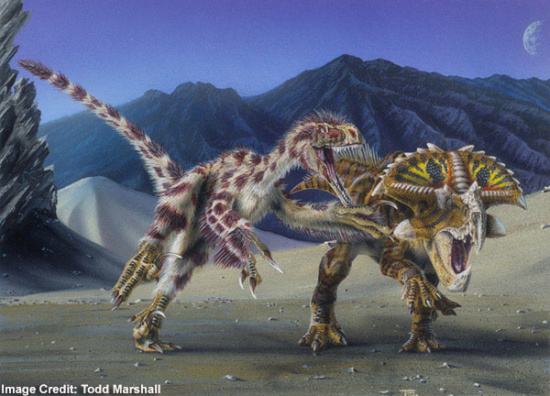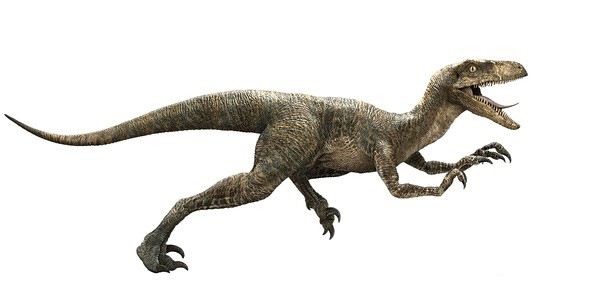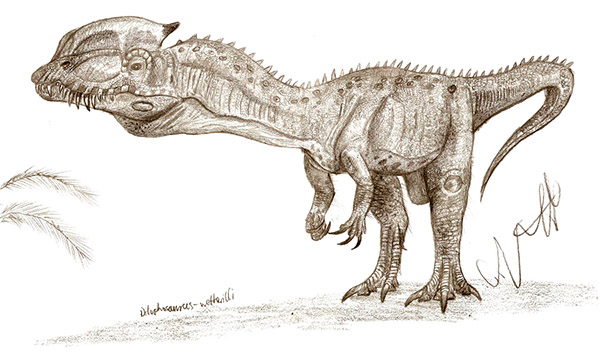Dinosaur Knowledge Tips Velociraptor
Release time:2017/10/14 15:47:00

Velociraptor (; meaning "swift seizer" in Latin) is a genus of dromaeosaurid theropod dinosaur that lived approximately 75 to 71 million years ago during the later part of the Cretaceous Period. Two species are currently recognized, although others have been assigned in the past. The type species is V. mongoliensis; fossils of this species have been discovered in Mongolia. A second species, V. osmolskae, was named in 2008 for skull material from Inner Mongolia, China.
Smaller than other dromaeosaurids like Deinonychus and Achillobator, Velociraptor nevertheless shared many of the same anatomical features. It was a bipedal, feathered carnivore with a long tail and an enlarged sickle-shaped claw on each hindfoot, which is thought to have been used to tackle and disembowel prey. Velociraptor can be distinguished from other dromaeosaurids by its long and low skull, with an upturned snout.
Velociraptor (commonly shortened to "raptor") is one of the
dinosaur genera most familiar to the general public due to its prominent
role in the Jurassic Park motion picture series. In real life, however, Velociraptor was roughly the size of a turkey, considerably smaller than the approximately 2 m (7 ft) tall 80 kg (180 lb) reptiles seen in the films. Today, Velociraptor is well known to paleontologists, with over a dozen described fossil skeletons, the most of any dromaeosaurid. One particularly famous specimen preserves a Velociraptor locked in combat with a Protoceratops.

Velociraptor was a mid-sized dromaeosaurid,
with adults measuring up to 2.07 m (6.8 ft) long, 0.5 m (1.6 ft) high
at the hip, and weighing up to 15 kg (33 lb), though there is a higher
estimate of 19.7 kg (43 lb). The skull, which grew up to 25 cm (9.8 in) long, was uniquely
up-curved, concave on the upper surface and convex on the lower. The
jaws were lined with 26–28 widely spaced teeth on each side, each more
strongly serrated on the back edge than the front.Velociraptor, like other dromaeosaurids, had a large manus ('hand') with three strongly curved claws, which were similar in construction and flexibility to the wing bones of modern birds. The second digit was the longest of the three digits present, while the first was shortest. The structure of the carpal (wrist) bones prevented pronation of the wrist and forced the 'hands' to be held with the palmar surface facing inwards (medially), not downwards. The first digit of the foot, as in other theropods, was a small dewclaw. However, whereas most theropods had feet with three digits contacting the ground, dromaeosaurids like Velociraptor walked on only their third and fourth digits. The second digit, for which Velociraptor is most famous, was highly modified and held retracted off the ground.
It bore a relatively large, sickle-shaped claw, typical of dromaeosaurid
and troodontid dinosaurs. This enlarged claw, which could grow to over 6.5 cm (2.6 in) long around its outer edge, was most likely a predatory device used to tear into or restrain struggling prey.
As in other dromaeosaurs, Velociraptor tails had long bony projections (prezygapophyses) on the upper surfaces of the vertebrae, as well as ossified tendons underneath. The prezygapophyses began on the tenth tail (caudal)
vertebra and extended forward to brace four to ten additional vertebrae,
depending on position in the tail. These were once thought to fully
stiffen the tail, forcing the entire tail to act as a single rod-like
unit. However, at least one specimen has preserved a series of intact
tail vertebrae curved sideways into an S-shape, suggesting that there was considerably more horizontal flexibility than once thought. In 2007, paleontologists reported the discovery of quill knobs on a well-preserved Velociraptor mongoliensis forearm from Mongolia, confirming the presence of feathers in this species.

During an American Museum of Natural History expedition to the Outer Mongolian Gobi Desert, on 11 August 1923 Peter Kaisen recovered the first Velociraptor fossil known to science: a crushed but complete skull, associated with one of the raptorial second toe claws (AMNH 6515). In 1924, museum president Henry Fairfield Osborn designated the skull and claw (which he assumed to come from the hand) as the type specimen of his new genus, Velociraptor. This name is derived from the Latin words velox ('swift') and raptor ('robber' or 'plunderer') and refers to the animal's cursorial nature and carnivorous diet. Osborn named the type species V. mongoliensis after its country of origin. Earlier that year, Osborn had mentioned the animal in a popular press
article, under the name "Ovoraptor djadochtari" (not to be confused with
the similarly named Oviraptor). However, because the name "Ovoraptor" was not published in a scientific
journal or accompanied by a formal description, it is considered a nomen nudum ('naked name'), and the name Velociraptor retains priority.
While North American teams were shut out of communist Mongolia during the Cold War, expeditions by Soviet and Polish scientists, in collaboration with Mongolian colleagues, recovered several more specimens of Velociraptor. The most famous is part of the famous "Fighting Dinosaurs" specimen (GIN 100/25), discovered by a Polish-Mongolian team in 1971. This fossil preserves a single Velociraptor in the midst of battle against a lone Protoceratops. This specimen is considered a national treasure of Mongolia, although
in 2000 it was loaned to the American Museum of Natural History in New York City for a temporary exhibition. Between 1988 and 1990, a joint Chinese-Canadian team discovered Velociraptor remains in northern China. American scientists returned to Mongolia in 1990, and a joint
Mongolian-American expedition to the Gobi, led by the American Museum of
Natural History and the Mongolian Academy of Sciences, turned up several well-preserved skeletons. One such specimen, IGM 100/980, was nicknamed "Ichabodcraniosaurus" by
Norell's team because the fairly complete specimen was found without its
skull (an allusion to the Washington Irving character Ichabod Crane). This specimen may belong to Velociraptor mongoliensis, but Norell and Makovicky concluded that it was not complete enough to say for sure, and it awaits a formal description.
Maxillae and a lacrimal (the main tooth-bearing bones of the upper jaw, and the bone that forms
the anterior margin of the eye socket, respectively) recovered in 1999
by the Sino-Belgian Dinosaur Expeditions were found to pertain to Velociraptor, but not to the type species V. mongoliensis. Pascal Godefroit and colleagues named these bones V. osmolskae (for Polish paleontologist Halszka Osmólska) in 2008.
from Wikipedia